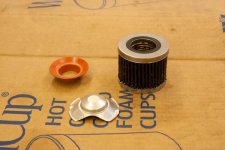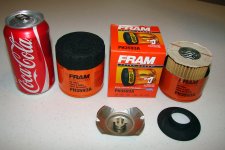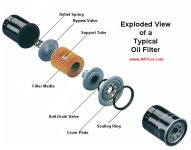crazyal
Super Member
As of right now i dont go looking for frams to use but if it is on a deal i get i use it on one of the older vehicles. I have to admit most of my hesitance is from this internet "lore" of them, BUT i do admit that looking into the filters i sometimes see plastic in them when i use to see metal in the same application, which has driven me away more than the so called falure stories that you hear on the net.. Massey being the first to actually say that it happened to him on one of his vehicles with a fram.
The problem is that just because a part failed it doesn't mean that it was the cause of the failure. For example, if you run an engine without oil and you throw a rod you wouldn't blame the rod. However if the rod was defective and broke then you would blame it. The same is true for filters. People want to blame something but rarely actually take the time to find out what happened. When you see a spin on filter that's been cut open and the filter media has collapsed it's usually from one of two different failures. The first is that the filter's internal pressure relief valve didn't open while the second is that the oil pumps internal pressure regulation valve stuck closed.
Oil filter relief valves are usually set to about 12 psi. Since they just look at the pressure before and after the filter media (not the over all pressure) they are set to work with the type of media the filter. They are designed to deal with things like cold oil that will not flow through the media fast enough. Quick revving of the engine sending a rush of oil into the filter that creates a quick, but temporary, pressure spike, and for when the media or oil is old and dirty.
The oil pump pressure regulator is like the hydraulic pressure regulator on your tractor. It's job is to not let the hydraulic system's pressure go beyond a specific level. In your tractor it's probably 2500 psi or so. In your engine it's probably 80 psi or less. When working correctly and bleeding off extra pressure it's also allowing extra oil to flow back into the oil pan. When it fails it will send a spike in both pressure and oil flow into the filter. Filters are not designed to handle the increased flow and collapse. If the regulator valve stays stuck it can actually swell the steel sides of the filter housing and even blow out the filter gasket. If it's temporary and the regulator valve starts working again you may not notice, you may notice if you cut open the filter, or it could do enough damage to the filter so it blocks oil flow destroying the engine. An engine builder told me that older engines with bearings with wear on them are more likely to suffer a collapsed filter media since the oil has less resistance after the filter.
I was told when I was racing that special race filters were designed with regulator failures in mind and could flow the extra oil because they have an extra large oil bypass valve in the filter to deal with the high RPMs and sudden engine acceleration that race engines often see. I have yet to see any of these filter comparisons actually try to measure how much oil can flow through the bypass. It could be possible that the Fram filters do not allow enough oil to flow in bypass mode and that's why some fail or it could be simply because they are the most popular filter (because of their low price and abundance of sellers).
You're best defense is to change your oil and filter often no matter the brand or type of oil. Clean new oil will flow through a filter much easier than older oil. Older filter media will be partially blocked by the contaminates it has filtered out of the system. The more engine hours the more plugged it will be. In reality it's very rare and if you look around the internet you can find an example of almost every brand that has failed.


